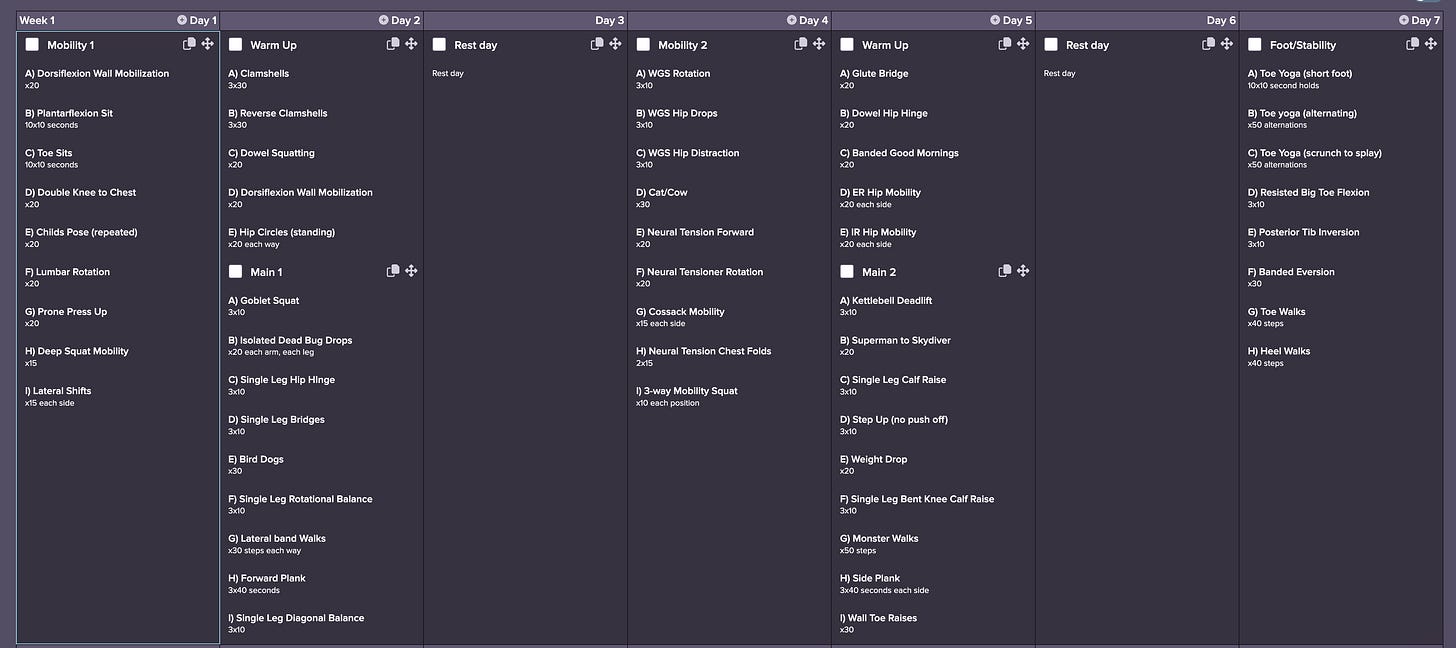I’ve worked with runners for a long time. I first worked with them in an insurance based clinic for 5 years and while it was great, I was constantly met with barriers in this model — limited visits approved by insurance, juggling sometimes 4 patients at once, scheduling issues and more. Then I left and started a cash based clinic where I could set the rules. This meant 1-on-1 visits, adequate time with my clients, giving thorough home exercise plans, etc., yet I was STILL met with barriers — financial constraints, frequency of visits, and time constraints.
When I was in the insurance based clinic I thought to myself “there has to be a better way”, so I thought I created a better way only to continue thinking to myself “there has to be a better way”
Both these models are decent at getting through the initial stages of injury, but follow through and longevity were constant struggles with clients in this model.
During my time in the cash based model, I started adding something different to the clients recovery and progression… I started adding in more comprehensive work to be done in between sessions. Especially when there were several weeks in between an in person session, I’d make sure there was adequate progression in their take home program so we can keep moving forward when we met up again. I quickly saw these clients progressing MUCH faster than previous clients.
I gradually began transitioning my in-person clients to FULLY at home programs and saw the SAME progress as the combo, both of which were much better than the sporadic in-person model.
Then I thought to myself… “okay, I think I found the way”.
So, what exactly is remote strength and rehab training?
As the question suggests, its strength programming done remotely… This means rather than meeting clients every time for a strength or rehab session, I outline specifically what I want them to do on their own time. I instruct clients to complete a specific grouping of exercises on specific days and I have them report back to me with feedback on how things are feeling, what worked, what didn’t work, etc.
With good feedback and communication, this allows me to dynamically adjust programming as needed to fit current severity and irritability or progress/regress someone as needed.
Why does it work better than the in-person model?
There are a few reasons for this:
More routines = higher success — in this model, I am able to write out what I believe will make someone better. Especially for runners, when there is an injury or if they are trying to improve performance, there is A LOT to work on. Stability, mobility, balance, motor control, strength, impact control and more. Its nearly impossible to fit all this in during a single session (most commonly clients come into the clinic 1x/week or every other week which just didn’t cut it). I might give a client 5 unique routines to go through during a week and then progress those routines the next week. This means they can have a much more thorough program in place.
More cost effective = better longevity — in the in-person model or cost per session model, things add up QUICK. The average cost for a 1-on-1 PT session is around ~$130/session (this can be true with or without insurance believe it or not). If my recommendation is coming to PT for a comprehensive program 2-3x per week, this might be costing someone several hundred dollars per week, which is just not realistic, so clients usually fall back to 1x per week or every other week which isn’t optimal. With the remote coaching model, monthly costs are drastically lower than even coming in 1x per week, so they get more routines for less money and the opportunity to create a habitual routine.
More time efficient = more consistency — simply put, clients can do what they want when they want to. No timing issues, no scheduling, no commuting, just fitting it in the day when they’re able to.
Real time feedback = quicker changes — rather than waiting for the next appointment, clients can comment or message feedback ASAP and get changes to their program in a reasonable amount of time rather than waiting weeks for the next time they see their provider. This means working through an issue can happen much faster, which means clients get better sooner.
What remote coaching looks like specifically
There are 3 main components to remote strength coaching. The first is setting up a call where we can discuss goals, talk through issues, look at movement and develop a plan of what working together is going to look like.
Second, this is the program itself. Based on our initial conversation, I build out a program that is specific for the goals and issues a client might have. I deliver this program on an app that shows the daily routines, with exercise descriptions and video demonstrations.
The third and most crucial part of the program is communication. Having good feedback from clients allows me to make appropriate changes to the program. This might be as simple as commenting on a workout of what felt good and what didn’t or letting me know how a recent ran went or filling me in on any developing issues, either way, effective communication allows me to keep the program adaptable and fitting for what we need.
So, is a virtual program something that would work for you?
In short, for most people the answer is yes. It’s a great and thorough way to dive into strength work with good feedback and progression. It sure beats piecing together random bits of exercises to see what they amount to. It creates intention in a program, making it dynamic and thorough.
Remember, its not exercises that make people better. Its how various exercises are grouped into routines and how those routines are grouped into a well thought out program.
If you want to talk more about this to see what might work for you, lets set up a free call to see what you need and how it could help.



